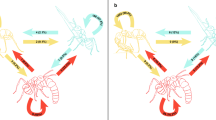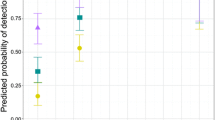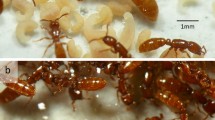Summary
Caste theory states that the proportions of individuals in different demographic classes of an insect society should vary with environmental factors, and are adaptive because they enhance colony-level efficiency. We examined the proportions of workers in different age and size classes (temporal and physical castes) in whole colonies of the ant Pheidole dentata collected in two different habitats. Despite significant ecological differences between the habitats in competition, resource availability and predation, we found no differences in the physical and temporal caste structures of colonies. Also, there was no correlation between physical or temporal caste ratios and the reproductive output of colonies. Because of topography, distance between sites, and apparent low vagility of Pheidole alates, we assume that gene flow between the sites is inadequate to account for the observed similarities. Although age- and size-related patterns of division of labor were observed, similarities in the behavioral profiles (the sum of the relative contributions of each age cohort to the performance of tasks) in colonies having different age caste structures suggests that worker, flexibility may be more important than rigidly programmed age- and size-correlated patterns of task performance.
Similar content being viewed by others
References
Bhatkar A (1978) Ants of the red clay hills near Tallahassee, Florida. Tall Timbers Research Station Library, pp 150
Blaisdell RS, Wooten J, Godfrey RK (1973) The role of magnolia and beech in forest processes in the Tallahassee, Florida and Thomsville, Georgia area. Proc Ann Tall Timbers Fire Ecol Conf 13:363–397
Calabi P (1986) Division of labor in the ant Pheidole dentata: the role of colony demography and behavioral flexibility. PhD thesis Boston University
Calabi P (1988) Behavioral flexibility in Hymenoptera: a reexamination of the concept of caste. In: Trager JC (ed) Advances in myrmecology. Brill Press, Leiden
Calabi P, Rosengaus R (1988) Interindividual differences based on behavior transition probabilities in the ant Camponotus sericeiventris. In: Jeanne RL (ed) Interindividual behavioral variability in social insects. Westview Press, Boulder
Calabi P, Traniello JFA (1988) Behavioral flexibility in age castes of the ant Pheidole dentata J Ins Behav (in press)
Calabi P, Traniello JFA, Werner MH (1983) Age polyethism: its occurrence in the ant pheidole hortensis, and some general considerations. Psyche 90:395–412
Davidson DW (1978) Size variability in the worker caste of a social insect (Veromessor pergandei (Mayr)) as a function of the competitive environment. Am Nat 112:523–532
Eastlake A, Chew RM (1980) Body size as a determinant of small scale distribution of ants in evergreen woodland in southeast Arizona. Insectes Soc 27:189–209
Gentry JB (1974) Responses to predation by colonies of the harvester ant Pogonomyrmex badius Ecology 55:1328–1338
Gregg RE (1942) The origin of castes in ants with special reference to Pheidole morrisi, (Forel). Ecology 23:295–308
Harrell FE (1983) The LOGIST procedure In: Joyner SP (ed) SUGI. Supplemental Library user's guide. SAS Inst Cary
Herbers JM (1980) On caste ratios, in ant colonies: population responses to changing environments. Evolution 34:575–585
Johnston A, Wilson EO (1985) Correlates of variation in the major/minor ratio, of the ant, Pheidole, dentata (Hymenoptera: Formicidae). Ann Entomol Soc Am 78:8–11
King RL, Sallee RM (1962) Further studies on mixed colonies of ants. Iowa Acad Sci 69:531–539
Kolmes SA (1985) An ergonomic study of Apis mellifera (Hymenoptera: Apidae). J Kansas Entomol Soc 58:413–421
Lehner PN (1979) Handbook of ethological methods. Garland Press, New York
Lenoir A (1979) Feeding behavior in young societies of the ant Tapinoma erraticum (L.): trophallaxis and polyethism. Insectes Soc 26:19–37
Leon County Soil Survey (1981) USDA Soil Conservation and Forest Service. Florida, Department of Agriculture and Consumer Services Capital Building, Tallahassee FL 57322
McDonald P, Topoff H (1985) The social regulation of behavioral development in the ant Novomessor albisetosus. J Comp Psychol 99:3–14
Meudec M, Lenoir A (1982) Social responses to variation in food supply and nest suitability in ants (Tapinoma erraticum). Anim Behav 30:284–292
Michener CD (1974) The social behavior of the bees: a comparative study. The Belknap Press of Harvard University Press, Cambridge
Mirenda JT, Vinson SB (1981) Division of labor and specification of castes in the red imported fire ant Solenopsis invicta (Buren). Anim Behav 29:410–420
Oster GF, Wilson EO (1978) Caste and ecology in the social insects. Princeton University Press, Princeton
Porter SD, Jorgensen CD (1981) Foragers of the harvester Pogonomyrmex owyheei — a disposable caste? Behav Ecol Sociobiol 9:247–256
Porter SD, Tschinkel WR (1985) Fire ant polymorphism (Hymenoptera: Formicidae): factors affecting worker size. Ann Entomol Soc Am 78:381–386
Porter SD, Tschinkel WR (1986) Adaptive value of nanitic workers in newly founded colonies of the imported fire ant Solenopsis invicta. Ann Entomol Soc Am 79:723–726
Schmid-Hempel P, Schmid-Hempel R (1984) Life duration and turnover of foragers in the ant Cataglyphis bicolor (Hymenoptera: Formicidae). Insectes Soc 31:345–360
Shaffer DT, Whitford WG (1981) Behavioral responses of a predator, the round tailed horned lizard, Phrynosoma modestum and its prey, honey pot ants, Myrmecocystus spp.. Am Mid Nat 105:209–216
Sokal R, Rohlf FJ (1969) Biometry. Freeman, San Francisco
Talbot M (1957) Population studies of the slave-making ant Leptothorax duloticus and its slave, Leptothorax curvispinosus. Ecology 38:449–456
Walker J, Stamps J (1986) A test of optimal caste ratio theory using the ant Camponotus (Colobopsis) impressus. Ecology 67:1052–1062
Wheeler DE (1986) Developmental and physiological determinants of caste in social Hymenoptera: evolutionary implications. Am Nat 128:13–34
Whitcomb WH (1967) Field studies on predators of the secondinstar bollworm, Heliothis zea (Boddie). J Ga Entomol Soc 2:113–118
Whitcomb WH, Bhatkar A, Nickerson JC (1973) Predators on Solenopsis invicta queens prior to successful colony establishment. Environ Entomol 2:1101–1103
Whitcomb WH, Gowan TD, Buren WF (1982) Predators of Diaprepes abbreviatus (Coleoptera: Curculionidae) larvae. Fla Entomol 65:150–158
Whitford WG, Bryant M (1979) Behavior of a predator and its prey, the horned lizard (Phrynosoma cornutum) and harvester ants (Pogonomyrmex spp.). Ecology 60:686–694
Wilson EO (1957) The organization of a nuptial flight of the ant Pheidole sitarches Wheeler. Psyche 64:46–50
Wilson EO (1968) The ergonomics of caste in the social insects. Am Nat 102:41–66
Wilson EO (1971) The Insect Societies. Belknap Press of Harvard University Press, Cambridge
Wilson EO (1975) Enemy specification in the alarm-recruitment system of an ant. Science 190:798–800
Wilson EO (1976a) Behavioral discretization and the number of castes in an ant species. Behav Ecol Sociobiol 1:141–154
Wilson EO (1976b) Which are the most prevalent ant genera? Studia Ent 19:187–200
Wilson EO (1983a) Caste and division of labor in leaf-cutter ants (Hymenoptera: Formicidae: Atta). III. Ergonomic resiliency in foraging by A. cephalotes. Behav Ecol Sociobiol 14:47–54
Wilson EO (1983b) Caste and division of labor in leaf-cutter ants (Hymenoptera: Formicidae: Atta). IV. Colony ontogeny of A. cephalotes. Behav Ecol Sociobiol 14:55–60
Wilson EO (1985) The sociogenesis of social insect colonies. Science 228:1489–1495
Author information
Authors and Affiliations
Rights and permissions
About this article
Cite this article
Calabi, P., Traniello, J.F.A. Social organization in the ant Pheidole dentata . Behav Ecol Sociobiol 24, 69–78 (1989). https://doi.org/10.1007/BF00299638
Received:
Accepted:
Issue Date:
DOI: https://doi.org/10.1007/BF00299638




